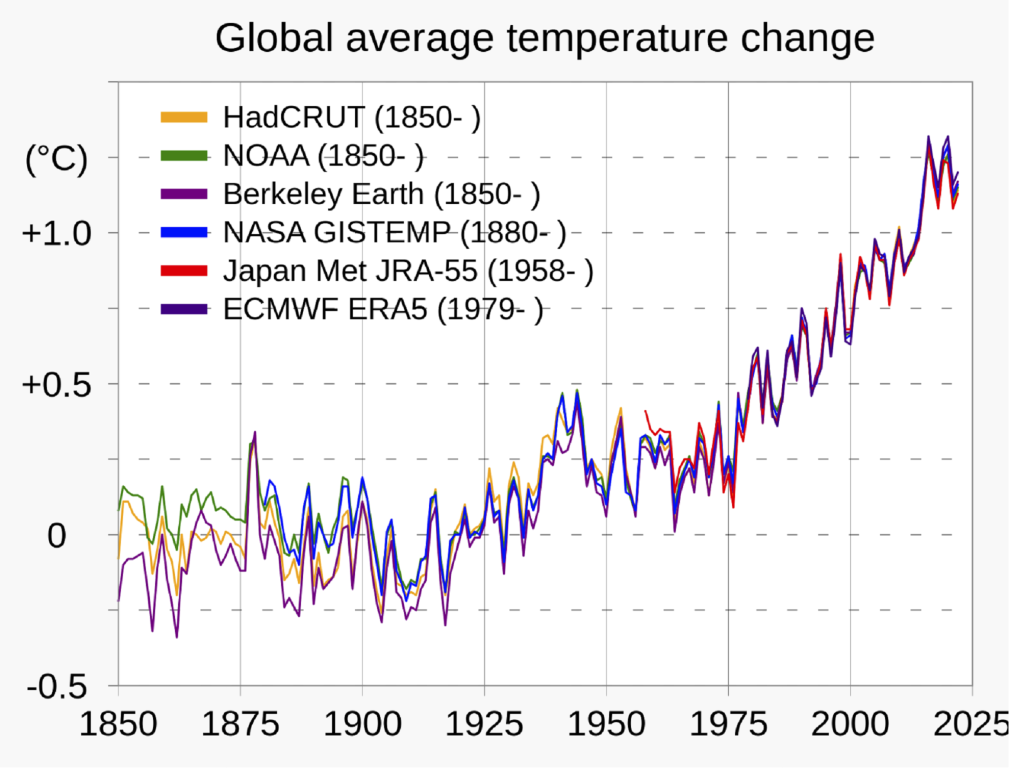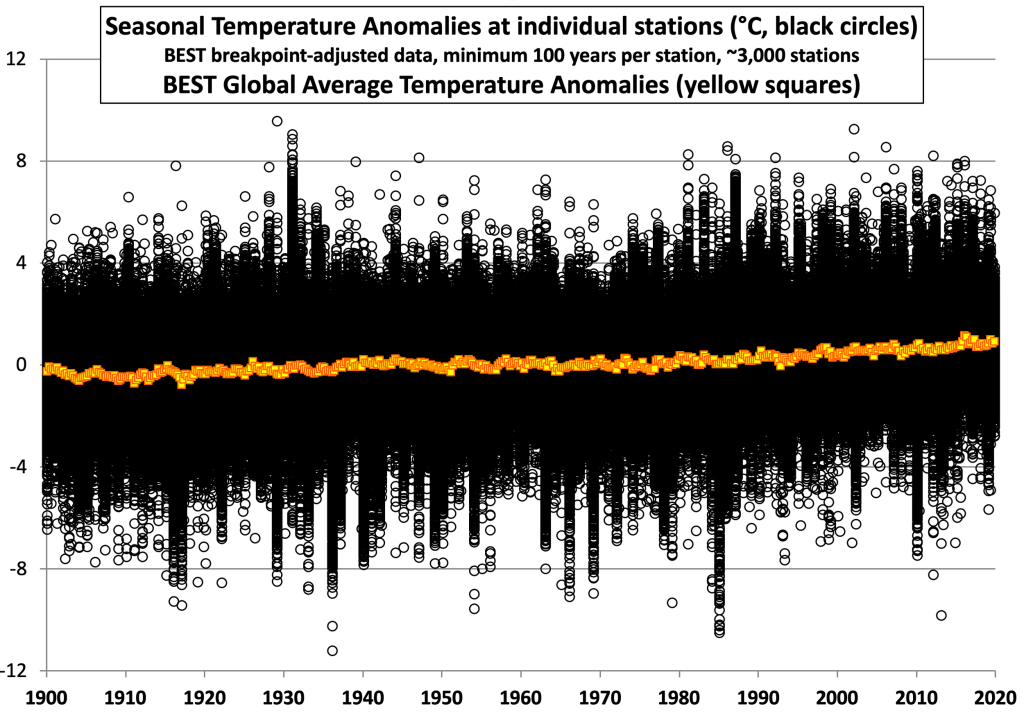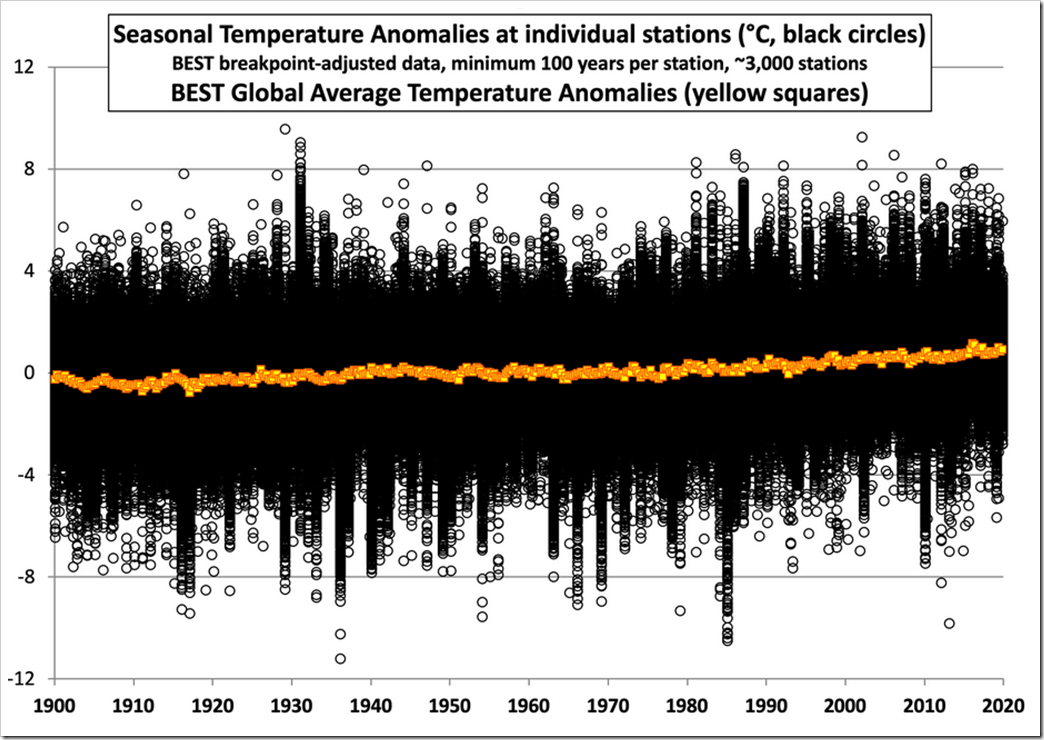What Is Climate?–Richard Lindzen
By Paul Homewood
Nice summary by Richard Lindzen:
We are generally told that the following defines ‘climate’…

Figure 1 Global average temperature anomaly.
Actually, we are not looking at ‘average temperature’. Averaging Mt. Everest and the Dead Sea makes no sense. Instead, we average what is called the temperature anomaly. We average the deviations from a 30-year mean. The figure shows an increase of a bit more than 1°C over 175 years. We are told by international bureaucrats that when this reaches 1.5°C, we are doomed. In all fairness, even the science report of the UN’s IPCC (i.e. the WG1 report) and the US National Assessments never make this claim. The political claims are simply meant to frighten the public into compliance with absurd policies. It remains a puzzle to me why the public should be frightened of a warming that is smaller than the temperature change we normally experience between breakfast and lunch.
My puzzlement becomes clearer when one includes the data points in Figure 1, as shown in Figure 2. This was first noted by Stanley Grotch, and updated by John Christy and I).

Figure 2 Temperature anomalies at individual stations as well as the mean.
We see that the data points are spread pretty densely over a range of about 16°C – over an order of magnitude greater than the range of the mean. The change in Figure 1 looks big simply because the data points are left out and the scale is expanded by over an order of magnitude.
What exactly does this say about climate? In point of fact, the Earth has dozens of different climate regimes. This is shown in Figure 3 showing the Koppen climate classification for the period 1901-2010. Each of these represents different interactions with their environments. Are we really supposed to think that each of these regimes responds in lock-step with the global mean temperature anomaly? On the contrary, Figure 2 tells us that at any given time, there are almost as many stations cooling as are warming.

Figure 3 Koppen climate classification.
Of course, the notion that global average temperature anomaly constitutes ‘climate’ is attractive due to its simplicity.
Unfortunately, that doesn’t mean that it is correct.
https://www.netzerowatch.com/all-news/what-is-climate?mc_cid=6084154d58&mc_eid=4961da7cb1
I was particularly intrigued with Figure 2:
I know it’s only eyeballing, but if you back to 1980, there appears to be little increase in the positive anomalies, but there is a noticeable reduction in negative ones. It is something I have often seen in UK data, that average temperature rise is being driven by less extreme cold weather, rather than more extreme heat.
Comments are closed.


A reduction in cold temperatures would be expected, if the monitoring stations were merely recording human energy usage and UHI effects.
I wonder how this compares with the satellite data, from 1980 onwards?
R
“…compares…?”
Rather similar.
https://images.remss.com/msu/msu_time_series.html
The Satellite record is less monotonic. It also shows the ‘spike’ effects of the El Ninos
The most recent El Nino seems to be waning, and so the measurements should drop significantly over the next six months.
ABOVE the lower troposphere, there has been no sign of warming at all.
Of course, the usual caution, that ALL climate temperature series fail to be measurements of temperature at all but merely of certain manifestations of the infinitely varied flows of heat in the world, holds. Also, we must remember that the sea is much more important as a driver of developments than the air. Changes in the sea are slow. The heat capacity of the world ocean is 1,400 times that of the atmosphere.
It is not very obvious in my post that there are TWO analyses of the satellite data. The UAH one has appeared as a graph. The blue link looks as if it is the source for the chart but actually it links to RSS analysis.
Since 2016, the UAH and RSS series have been in virtual lockstep. These two independent analyses confirm each other.
(Dave)
Is there any correlation with surface albedo, as measured by the various Earth observation satellites.?
The Dark Snow Project found significant reductions in Arctic albedo, from forest fires and Chinese industrial emissions. But they could not get more funding, for further research.
https://image.sciencenordic.com/1409615.jpg?imageId=1409615&width=1058&height=604
R
“…surface albedo, as measured [sic]…”
There is no ‘measurement;’ merely the usual ‘silk purses out of pigs’ ears’ modelling.
The satellite analysis of ‘brightness temperatures’ delivers a time series that has so much more variability than any time series produced from the analysis of albedo, that it is hardly possible for a correlation to be statistically significant. And, in any case, what would be the correct time lags to use?
What is “Climate”? And what is the difference between “Climate” and “Weather”?
The definitions I usually use are that “Climate” is the behaviour of the atmosphere as a whole, while “Weather” is the behaviour of the atmosphere as it interacts with the surface of the planet.
Both are subject to entire different sets of influences, both complex and both with entirely different behaviour patterns.
Interestingly, there was a speech in the House of Lords yesterday where it was pointed out, basically, that the IPCC scientific report stated that the current ranges of climatic assessments, from storms to sea level rises, were well with normal parameters and not cause for serious concern. Does show that there is some common sense among the political classes !
Just for reference; the speech referred to was by Lord Lilly and may be found at : https://www.theyworkforyou.com/lords/?id=2024-01-18a.521.0#g523.0
Long live the good professor. Many years ago I went to listen to an inspiring talk he gave in the Houses of Parliament, but of course the politicians who should have been there to listen were all absent. He once correctly stated that these days second (more likely third rate) scientists make a career of climate science as it is an easy route to make money and get in the media. Top scientists go in for something much more difficult, interesting and useful. How true his statement remains.
Googling to see what atmospheric CO2 concentration the IPCC CAGW activists believed would cause the planet’s temperature to reach 1.5 degrees C above the pre Industrial Revolution level I came across :
https://www.metoffice.gov.uk/research/news/2018/how-much-co2-at-1.5c-and-2c
where the Met Office write :
“At 1.5 °C or 2 °C above pre-industrial temperatures, the concentration of carbon dioxide (CO2) in the atmosphere will be higher than it is today, with impacts on land and marine ecosystems, and on food production.
Based on the TCR estimated from observational constraints in IPCC AR5, this paper estimates median CO2 concentrations at 1.5 and 2 °C of 507 ppm and 618 ppm, respectively.”
Is this not the wrong way round? Surely, the IPCC’s CAGW theory should be that increasing CO2 concentration from anthropogenic emmissions determines the temperature, not the temperature determining the CO2 concentration?
And won’t higher CO2 levels green the planet and increase food production?! Or is this bad for the planet?
I believe the IPCC (the science bit) concluded long ago the any warming would be in the northern hemisphere, at night in winter.
Whilst it’s anecdotal (from whence spills most scientific hypothesis) I witnessed abrupt warming in Scotland in the mid to late 1970’s. Our local Loch used to freeze over every year and there were hundreds of people skating on it at times.
It stopped freezing every year, abruptly, in the 70’s. This would be consistent with what the IPCC tells us, only it happened before they told us.
In every other respect, Scottish summers remain entirely unchanged. It still chucks it down.
Willis Eschenbach posted to this site the UAH data for the UK from 1979 to 2022 and concluded that the UK’s warming was nearly double the world average:
Willis Eschenbach PERMALINK
January 4, 2023 1:32 am
“The difference in the trends is fairly large:
CET Trend, 1979 – 2000: 0.29°C/decade
UAH MSU Trend, 1979 – 2000: 0.16°C/decade”
[The data was to 1979 to 2002, 2000 was a typo]
Sorry, 1979 to 2022!
I’d be prepared to bet most warming was early on.
Parliamentary climate alarmism seems to boil down to inattentive, bigoted, or activist MPs lobbied or ‘bribed’ by vested interests to a point where the public can afford it no more. Richard Lindzen has been a shining light in the dark doom of climate alarmism. Thank goodness.
Prof Lindzens graph of temperature anomolies at INDIVIDUAL recording stations made perfect common sense to this comparative “climate” layman;
a very clear expose’. As a keen, small scale, outdoor veg grower in S Devon for many years I also fully agree with Mr Homewood’s comment – summer temperatures are no higher now than say 30 years ago but winters are less cold and the warmer growing period is now slightly longer.
Another interesting factor that no-one mentions is hours of sunshine which the MET Office records:-
https://www.metoffice.gov.uk/research/climate/maps-and-data/uk-temperature-rainfall-and-sunshine-time-series
The interesting thing about this chart is that sunshine hours are increasing just like the fabled global warming. There was a big dip for some reason during the 70s in the UK when we were panicking about global cooling.
The causes for changes in sunshine hours are not explained, but I suspect it is due to particulates in the atmosphere from smoke. Since we no longer have fireplaces, the atmosphere has been cleaned up and there is more sunshine.
Eric Negron is a great source of historical temp data and delves into how they measure today often finding we don’t really know how they measure today especially around the temperatures for the periods chosen as a baseline for what the globe has supposed to have warmed from.
You can find him on the FaceBook site “scientists skeptical of anthropogenic global warming” and comments right now concerning the same points made in the heading.
I asked him some questions and got great replies although it’s a difficult subject for me, often seems it’s all a math product than real data these days from the climate institute sources.
Also Willis Eschenbach posted a climate report for 2023 on WUWT and showed that the land temperature according to most data bases has already surpasses 1.5 C and is 2 C, well oops IPCC!
https://www.facebook.com/groups/592667610853437
The Lindzen post above is an excerpt from a more comprehensive Lindzen publication from Net Zero Watch:
https://www.thegwpf.org/content/uploads/2022/09/Lindzen-global-warming-narrative.pdf?mc_cid=d5f95de4d7&mc_eid=4961da7cb1
It is very informative on a number of additional issues, especially the misconception of “arctic amplication.”
“If you are going to blame everything on carbon dioxide, you have to explain why, on all timescales, temperatures in the tropics are extremely stable while those in high latitudes are much more variable. The IPCC’s story is that small amounts of greenhouse warming near the equator are ‘amplified’ at high latitudes. But neither theory nor data support the idea of amplification.”
Instead, says Lindzen, this pattern – of stable tropical temperatures and fluctuating ones in high latitudes – is mostly a function of natural processes in the atmosphere and oceans; in other words, changes in oceanic and atmospheric currents that transport heat poleward while drawing varying amounts of heat out of the tropics. These changes in transport affect the tropics, but they are not determined by the tropics.
“The changes in the earth’s so-called temperature are mainly due to changes in the temperature difference between the tropics and the poles – at least for major changes. The changes in tropical temperature, which are influenced by greenhouse processes, are a minor contribution.”
My synopsis is:
This is the first explanation i’ve seen of why the axis label is anomalies rather than the degrees thermometers show. Newspapers have been publishing thermometer readings for over a century. Why not graph those?